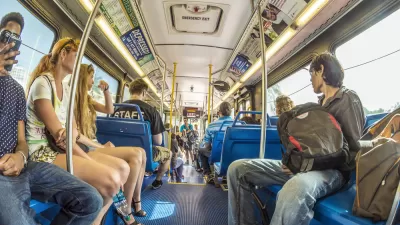An interview with a photographer about his unflattering pictures of train riders in Tokyo's crowded subway.
In his series called "Tokyo Compression," Michael Wolf, took photos of Japanese commuters on crowded trains. According to an interview with Mr. Wolf by CNN's Zahra Jamshed, "Wolf, who lives in Hong Kong, often uses photography to critique the harsh living conditions of large cosmopolitan cities."
"These people are squeezed against the back walls as more and more people are shoveled in. You're living life as a sardine -- it's horrific. This is not a dignified way of living. It's like looking into a ride in hell." Some train riders might point out that all commuters look uncomfortable from time to time as they ride to work. And that, while they might not love the rush hour squeeze, they might not appreciate being photographed at their worst to make the point that they are living in "hell."
But Wolf was intent on capturing the most dramatic and unflattering aspects of the commute. As he explains, "The entire process took four years because the first images I took had no condensation on the windows. The next time I was there, there was more condensation because of the change in season, so the pictures became more dismal and I was able to better express what it was that I wanted."
In the interest of giving Mr. Wolf the benefit of the doubt, he doesn't universally pity all mass transit commuters, later in the interview he allows that, "there are cities around the world that are planned more sensibly." That's almost certainly true, though it's funny to read it in the same outlet which ranked Tokyo's metro system among the 10 best in the world.
FULL STORY: A ride in hell? An up-close look at real life in megacities

Alabama: Trump Terminates Settlements for Black Communities Harmed By Raw Sewage
Trump deemed the landmark civil rights agreement “illegal DEI and environmental justice policy.”

Planetizen Federal Action Tracker
A weekly monitor of how Trump’s orders and actions are impacting planners and planning in America.

Why Should We Subsidize Public Transportation?
Many public transit agencies face financial stress due to rising costs, declining fare revenue, and declining subsidies. Transit advocates must provide a strong business case for increasing public transit funding.

Understanding Road Diets
An explainer from Momentum highlights the advantages of reducing vehicle lanes in favor of more bike, transit, and pedestrian infrastructure.

New California Law Regulates Warehouse Pollution
A new law tightens building and emissions regulations for large distribution warehouses to mitigate air pollution and traffic in surrounding communities.

Phoenix Announces Opening Date for Light Rail Extension
The South Central extension will connect South Phoenix to downtown and other major hubs starting on June 7.
Urban Design for Planners 1: Software Tools
This six-course series explores essential urban design concepts using open source software and equips planners with the tools they need to participate fully in the urban design process.
Planning for Universal Design
Learn the tools for implementing Universal Design in planning regulations.
Caltrans
Smith Gee Studio
Institute for Housing and Urban Development Studies (IHS)
City of Grandview
Harvard GSD Executive Education
Toledo-Lucas County Plan Commissions
Salt Lake City
NYU Wagner Graduate School of Public Service




























